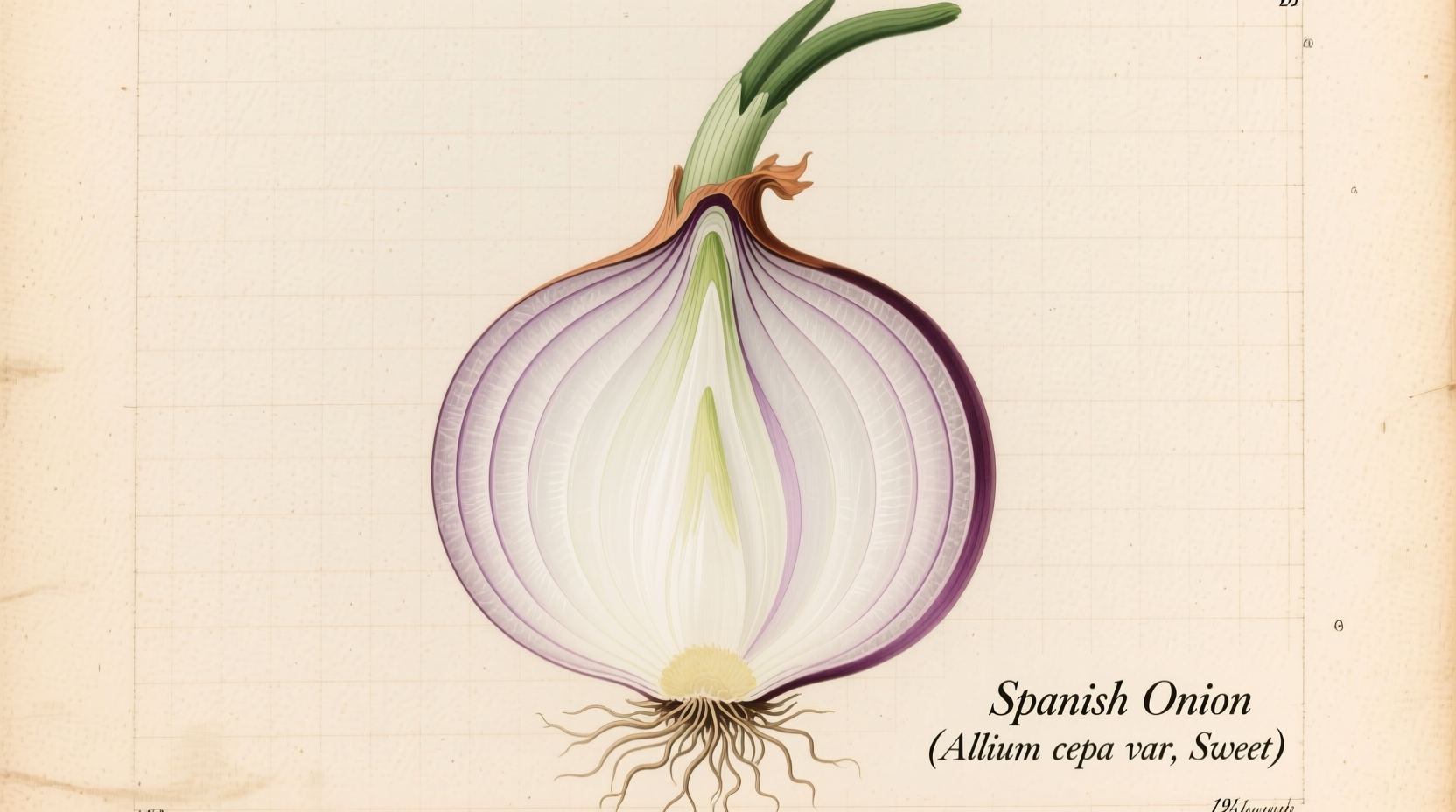Ever reached for an onion recipe only to wonder: what exactly is a Spanish onion? You're not alone. This common grocery store staple often causes confusion despite its widespread use. Let's cut through the uncertainty with clear, practical information you can use immediately in your cooking.
What Makes Spanish Onions Unique
Spanish onions stand out with their distinctive pale golden-brown skin and crisp white to light yellow flesh. Unlike their stronger relatives, these onions deliver a perfect balance of mild pungency and natural sweetness that makes them incredibly versatile. When sliced, they maintain their shape better than other yellow onions during cooking, making them ideal for caramelizing or grilling.

Spanish Onion vs Other Varieties: Key Differences
Understanding how Spanish onions compare to other common varieties helps you make better cooking decisions. Here's a detailed comparison of their characteristics:
| Onion Type | Flavor Profile | Best Cooking Uses | Storage Duration |
|---|---|---|---|
| Spanish Onion | Mild, slightly sweet | Raw applications, grilling, caramelizing | 2-3 months |
| Yellow Onion | Strong, pungent | Cooking, soups, stews | 2-3 months |
| White Onion | Sharp, crisp | Mexican cuisine, salsas | 1-2 months |
| Red Onion | Mildly sweet, colorful | Salads, pickling, garnishes | 3-4 weeks |
The Surprising History of Spanish Onions
Despite their name, Spanish onions didn't originate in Spain. According to agricultural records from the USDA Agricultural Research Service, these onions were actually developed in the United States during the early 20th century. The "Spanish" designation came from marketing efforts that associated the mild flavor with Spanish cuisine, creating a lasting misnomer. Commercial production expanded significantly after World War II when American farmers began cultivating larger, sweeter varieties that could withstand shipping better than traditional yellow onions.
When to Choose Spanish Onions
Spanish onions shine in specific culinary situations where their mild flavor and structural integrity provide advantages:
- Raw applications: Their lower sulfur content makes them less harsh when eaten raw in salads, sandwiches, or salsas
- Caramelizing: They develop beautiful golden-brown color with minimal stirring due to their natural sugar content
- Grilling: Their larger size and firm texture hold up well on the grill without falling apart
- French onion soup: Professional chefs prefer them for their balanced flavor that doesn't overpower the broth
However, they're not ideal for every situation. For strongly flavored dishes like chili or beef stew, traditional yellow onions provide better depth. Their mildness can get lost in robust recipes that benefit from more pungent onion varieties.
Practical Spanish Onion Substitutions
Ran out of Spanish onions? Here's how to adapt your recipe without compromising quality:
- For raw applications: Use white onions with a quick soak in cold water to reduce sharpness
- For cooking: Yellow onions work well but add 1/4 teaspoon of sugar per onion to compensate for less natural sweetness
- For grilling: Vidalia or other sweet onions make excellent substitutes when available
- Emergency swap: Combine half white onion and half red onion for balanced flavor in most recipes
Maximizing Freshness: Storage Tips
Proper storage extends Spanish onions' shelf life significantly. Keep them in a cool, dark, well-ventilated space away from potatoes (which release gases that accelerate spoilage). Never refrigerate whole Spanish onions, as the moisture promotes mold growth. Once cut, store unused portions in an airtight container in the refrigerator for up to 7 days. For long-term storage, freeze diced onions on a baking sheet before transferring to freezer bags—they'll maintain texture better for cooked dishes.
Nutritional Benefits Worth Noting
According to USDA FoodData Central, one medium Spanish onion (110g) provides:
- 44 calories
- 10g carbohydrates
- 2g dietary fiber (7% of daily value)
- 11mg vitamin C (12% of daily value)
- Significant quercetin content, a powerful antioxidant
Their lower pyruvic acid content compared to yellow onions contributes to their milder taste while still delivering similar health benefits associated with all onion varieties.
Putting Knowledge Into Practice
Next time you're at the grocery store, look for Spanish onions with firm, dry skins and no soft spots. Their larger size means you'll typically need fewer onions for recipes calling for this variety. When cooking, remember that their mild flavor means you can often use them more generously than stronger onion types—perfect for dishes where you want noticeable onion presence without overwhelming pungency.











 浙公网安备
33010002000092号
浙公网安备
33010002000092号 浙B2-20120091-4
浙B2-20120091-4